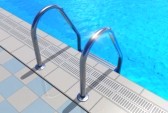 The homeowner decides it is time to shut down the pool for the winter – the kids are back in school, leaves are turning, and no one has used the pool for several weeks. It’s time to “winterize” the pool, to prevent problems from developing over the winter. But during the process, the homeowner doesn’t want to accidentally do something by adding chemicals which might stain the pool. So how can a pool owner perform a successful winterizing process without creating stains?
The homeowner decides it is time to shut down the pool for the winter – the kids are back in school, leaves are turning, and no one has used the pool for several weeks. It’s time to “winterize” the pool, to prevent problems from developing over the winter. But during the process, the homeowner doesn’t want to accidentally do something by adding chemicals which might stain the pool. So how can a pool owner perform a successful winterizing process without creating stains?
Read the instructions. According to Wisegeek.com, the first suggestion is to read the instructions on pool winterizing kits. The chemical treatment for winter is to introduce a mixture of winter chlorine, alkalizer, and powder to ensure that the pool stays clean over the winter. A number of manufacturers offer winterizing kits, and each has different directions. This is because some of the manufacturers recommend different products to accomplish the winterizing task. The nice thing about shutting down the pool for the cold months is that most pool winter kits are pre-measured – they have chemicals in proportions for just the size of pool in question.
Each of these winterizing kits will introduce extremely high levels of the chemicals into the pool. Some chemicals require that the pool filter be turned on while the chemicals are added. Some don’t require the use of the filter. Make sure to follow the directions for the kit that is being used – failure to do so could result in stains to the liner. If chemicals are incorrectly applied, it could result in a nasty surprise when the owner goes out to the pool in the spring. He could remove the pool cover to find an ugly stain on the pool liner, which would be difficult to remove, and require a lot of work to eliminate. Read the instructions.
Decide about chlorine. One suggestion is to use a non chlorine based winterizing kit. Chlorine based kits can reduce the effectiveness of algaecide and other winterizing chemicals, and can stain or bleach pool liners. A non-chlorine winterizing kit avoids that problem. The shock treatment available through using non-chlorine winterizing kits will kill micro-contaminants and algae, without the risk of stains.
Check the floater. Chlorine floaters – meant to release an oxidizer to keep the pool water fresh over the winter – can bump up against the side of a pool, and create a stain. The alternative is a slow release winter floater that releases a powerful non-chlorine oxidizer, avoiding the possibility of staining.
Watch the metals. Metals or minerals in the water can leave the pool with a number of issues – a stain on the liner, or waterline buildup. Using the proper chemical, a metal sequestering agent, from a pool winter kit can prevent that staining.
Take care of the whole process. In addition to the chemical process, don’t overlook the other elements of preparing the pool for winter, to minimize staining possibilities. Clean the pool of debris, such as leaves, bugs or any thing else floating in the pool. Give the pool a good brushing and scrubbing to start with clean surfaces when chemicals are added. Lower the water level in the pool, and put on a pool cover, to make sure the pool is properly protected against further contaminants.
About The Author
Candice Whiteside has spent many years writing, and is now working freelance for InTheSwim.com. She is also an aspiring artist, and finds that visualizing the arrangement of elements on a canvas is very similar to finding the just right way to arrange an article.

1 Comment